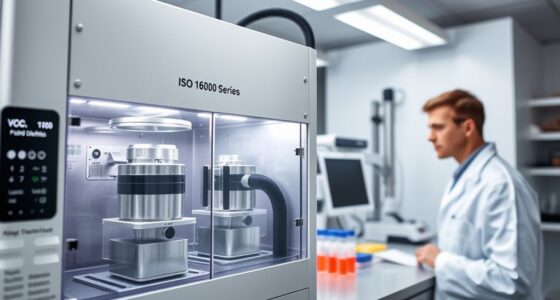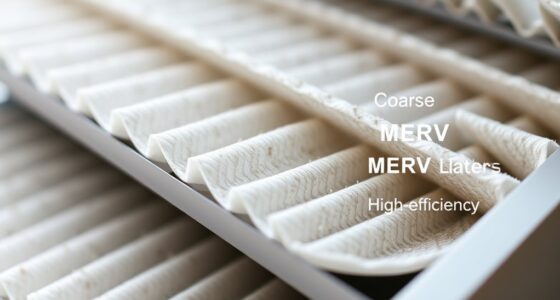ASHRAE 145.2 sets standardized testing protocols for evaluating gas-phase air-cleaning devices, guaranteeing their effectiveness in removing specific airborne contaminants. The certification process confirms that devices meet strict industry criteria through rigorous, reproducible tests that simulate real-world conditions. This helps you trust their performance claims and compare options confidently. If you want to understand how these tests ensure reliable results and what standards are applied, there’s more to discover below.
Key Takeaways
- ASHRAE 145.2 provides standardized testing protocols to evaluate the effectiveness of gas-phase air-cleaning devices.
- The standard ensures consistent evaluation of device performance against specific airborne contaminants.
- Certification confirms devices meet rigorous industry criteria through documented testing results.
- Testing protocols simulate real-world conditions, measuring contaminant removal or neutralization over time.
- Compliance with ASHRAE 145.2 helps consumers and professionals select reliable, verified air-cleaning solutions.

Have you ever wondered how to accurately determine the efficiency of a building’s heat recovery ventilation system? While your focus might be on thermal performance, understanding how gas-phase air-cleaning devices are tested is equally important. ASHRAE 145.2 provides a standardized framework for evaluating these devices, ensuring you can trust their claimed efficiencies and performance metrics. To do this effectively, you need to pay close attention to device certification and testing protocols outlined in the standard. These elements serve as the foundation for consistent, reliable assessments. Certification under ASHRAE 145.2 confirms that a gas-phase air-cleaning device has been evaluated according to strict criteria. When a device is certified, it means it has undergone rigorous testing to verify its ability to remove specific airborne contaminants efficiently. This certification process helps you distinguish between devices that meet industry standards and those that fall short. It also provides confidence that the device’s performance claims are backed by documented testing results, making it easier for you to select the right air-cleaning solution for your building. Additionally, understanding the testing protocols ensures that the data you rely on accurately reflects real-world performance. Testing protocols in ASHRAE 145.2 are designed to simulate real-world conditions as closely as possible, ensuring the data you rely on is accurate and meaningful. These protocols specify how tests should be conducted, including the types of contaminants used, airflow rates, and environmental conditions. For example, the testing involves challenging the device with a controlled concentration of pollutants, then measuring how much is removed or neutralized over a set period. By following these protocols, manufacturers produce comparable data, and you gain a clear understanding of each device’s capabilities. Moreover, the standard emphasizes reproducibility and repeatability in testing, which means that results can be trusted regardless of where or when they are performed. This consistency is essential for decision-making, especially when comparing multiple devices or evaluating new technologies. When you look at a certified device, you can be confident that its performance metrics are based on standardized testing procedures, not just marketing claims.
Frequently Asked Questions
How Often Should Gas-Phase Air-Cleaning Devices Be Tested?
You should test gas-phase air-cleaning devices regularly, typically at least every 12 months, to guarantee they meet performance standards. Testing intervals depend on the device’s usage, environment, and manufacturer recommendations. Regular testing helps verify that the filters are functioning correctly and maintaining indoor air quality. Keep detailed records of each test to track performance over time and ensure compliance with relevant standards.
What Are Common Challenges Faced During Testing Procedures?
Testing procedures often feel like steering through a maze, with challenges lurking at every turn. You face issues maintaining a controlled test environment, which can skew measurement accuracy. Variability in gas concentrations, device placement, and environmental factors makes it tricky to get consistent results. Additionally, ensuring calibration and replicating real-world conditions demand meticulous attention, making it essential to stay vigilant to produce reliable data and accurately assess device performance.
Are There Specific Safety Protocols for Conducting These Tests?
You should follow strict safety procedures to guarantee hazard mitigation during testing. This includes wearing appropriate personal protective equipment, working in well-ventilated areas, and monitoring for gas leaks or hazardous emissions. Always adhere to established protocols to minimize risks, such as handling chemicals carefully and maintaining proper equipment calibration. Implementing these safety measures helps protect you and others, ensuring a safe testing environment for gas-phase air-cleaning device evaluations.
How Do Testing Results Impact Device Certification Processes?
Your testing results directly influence device certification by demonstrating compliance with regulatory standards and validating performance metrics. When results meet or exceed these standards, manufacturers gain approval, ensuring safety and effectiveness. Conversely, poor results may lead to redesigns or rejection. This process helps maintain quality, protect consumers, and uphold industry credibility, making testing outcomes vital for bringing certified, reliable air-cleaning devices to market efficiently and confidently.
Can Portable Testing Equipment Be Used for On-Site Assessments?
Yes, portable testing equipment can be used for on-site assessments. You can perform accurate evaluations of gas-phase air-cleaning devices directly at the location, saving time and reducing disruptions. Make certain your portable testing tools are calibrated correctly and meet required standards to ensure reliable results. This approach allows you to quickly verify device performance and compliance without needing to transport samples to a lab, streamlining the certification process.
Conclusion
Think of ASHRAE 145.2 as your lighthouse, guiding you safely through the fog of airborne pollutants. By testing gas-phase air-cleaning devices, it acts as a trusted compass, helping you navigate towards healthier indoor air. Just as a lighthouse signals safe passage, this standard guarantees your devices are reliable, shining a clear light on air quality. Follow its guidance, and you’ll steer confidently toward a cleaner, healthier environment—your ultimate beacon of safety.










